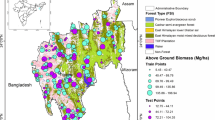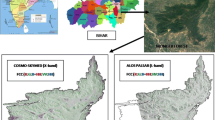Abstract
In satellite remote sensing, C-band synthetic aperture radar (SAR) sensors with the frequency of about 5.4 GHz and wavelength of about 5.5 cm interact heavily with the leaves, twigs and small stems. Hence, it is ideal for monitoring vegetation phenology, stratification of canopy closure/openness and biomass assessment of low- to medium-aboveground-biomass (AGB) density regions. Earth Observation Satellite-04 (EOS-04) is a C-band SAR mission from the Indian Space Research Organisation launched on 14 February 2022. This study presents the applications of EOS-04 data in forest phenological studies and biomass estimation in different vegetation conditions. Multi-temporal EOS-04 data were used to track the land surface phenology of tropical dry deciduous forests of Betul, Madhya Pradesh, which is mostly dominated by Tectona grandis. Phenological metrics were also derived from the tracked land surface phenology. For the mangrove forests of Sundarbans delta for two islands, namely Lothian and Dhanchi characterization in terms of canopy density and homogeneity/heterogeneity was carried out and AGB was estimated. The AGB values ranged from 29 to 241 Mg/ha, and the validation root mean square error (RMSE) was calculated to be 34 Mg/ha. EOS04 data were also used in combination with L-band ALOS PALSAR data for the forest biomass estimation in the part of Central India. Synergistic utilization of C- and L-band improves upon the individual models in terms of R2 and RMSE. L-band HV backscatter estimates AGB with a correlation coefficient of 0.49 which improved to 0.57 with the inclusion of C-band and estimates AGB with RMSE of 29 Mg/ha. This study successfully demonstrated the usability of EOS-04 for tracking land surface phenology and deriving phenological metrics from it, for the characterization of mangrove forests and it AGB estimation and for AGB estimation of forests in low-biomass regions.











Similar content being viewed by others
References
Ajai, N. S., Tamilarasan, V., Chauhan, H. B., Bahuguna, A., Gupta, M. C., Rajawat, A. S., Chaudhury, N. R., Kumar, T., Rao, R. S., Bhattacharya, S., Ramakrishnan, R., Bhanderi, R. J., Mahapatra, M., et al. (2012). Coastal zones of India. Space Applications Centre, Ahmedabad.
Bonan, G. (2008). Forests and climate change: Forcings, feedbacks, and the climate benefits of forests. Science, 320(5882), 1444–1449.
Briggs, S. V. (1977). Estimates of biomass in a temperate mangrove community. Austral Ecology, 2(3), 369–373. https://doi.org/10.1111/j.1442-9993.1977.tb01151.x
Brown, T., Hultine, K., Steltzer, H., Denny, E., Denslow, M., Granados, J., Henderson, S., Moore, D., Nagai, S., Sanclements, M., Sanchez-Azofeifa, G. A., Sonnentag, O., Tazik, D., & Richardson, A. (2016). Using phenocams to monitor our changing Earth: Toward a global phenocam network. Frontiers in Ecology and the Environment., 14, 84–93. https://doi.org/10.1002/fee.1222
Caballero, R. G., Platzeck, G., Pezzola, A., Casella, A., Winschel, C., Silva, S. S., Ludueña, E., Pasqualotto, N., & Delegido, J. (2020). Assessment of multi-date Sentinel-1 Polarizations and GLCM texture features capacity for onion and sunflower classification in an irrigated valley: An object level approach. Agronomy, 2020(10), 845. https://doi.org/10.3390/agronomy10060845
Chakraborty, M., et al. (2013). Initial results using RISAT-1 C-band SAR data. Current Science, 104, 490–501.
Clausi, D. A. (2002). An analysis of co-occurrence texture statistics as a function of grey level quantization. Canadian Journal of Remote Sensing., 28, 45–62. https://doi.org/10.5589/m02-004
FAO and UNEP. (2020). The State of the World’s Forests 2020. Forests, biodiversity and people. https://doi.org/10.4060/ca8642en
FRI. (1996). Indian woods: Their identification, properties and uses. Volume I-VI. Forest Research Institute, Ministry of Environment and Forests.
FSI. (1996). Volume equations for forests of India, Nepal and Bhutan Forest Survey of India. Ministry of Environment and Forests, Govt. of India
Garg, R. D., Agarwal, S., & Dadhwal, V. (2008). Evaluation of approaches for AWiFS multi-date registration. International Journal of Applied Earth Observation and Geoinformation, 10, 175–180. https://doi.org/10.1016/j.jag.2008.02.011
Ghosh, S. M., & Behera, M. D. (2021). Aboveground biomass estimates of tropical mangrove forest using Sentinel-1 SAR coherence data—The superiority of deep learning over a semi-empirical model. Computers and Geosciences. https://doi.org/10.1016/j.cageo.2021.104737
Gibbs, H. K., Brown, S., Niles, J. O., & Foley, J. A. (2007). Monitoring and estimating tropical forest carbon stocks: Making REDD a reality. Environmental Research Letters., 2(4), 045023. https://doi.org/10.1088/1748-9326/2/4/045023
Hayashi, M., Motohka, T., & Sawada, Y. (2019). Aboveground biomass mapping using ALOS-2/PALSAR-2 time-series images for Borneo’s Forest. IEEE Journal of Selected Topics in Applied Earth Observations and Remote Sensing, 12, 5167–5177. https://doi.org/10.1109/JSTARS.2019.2957549
Ilic, J., Boland, D., McDonald, M., Downes, G., & Blakemore, P. (2000). Woody density phase 1—State of knowledge. National carbon accounting system, Technical Report 18. Australian Greenhouse Office.
Joshi, H., & Ghose, M. (2014). Community structure, species diversity, and aboveground biomass of the Sundarbans mangrove swamps. Tropical Ecology., 55, 283–303.
Kaul, M., Mohren, G. M. J., & Dadhwal, V. K. (2011). Phytomass carbon pool of trees and forests in India. Climate Change, 108, 243–259.
Kumar, T., Das, P. K., Chandrasekar, K., Bandyopadhyay, S., & Dutta, D. (2021). Characterization of Indian Sundarban mangroves using airborne multi-configuration SAR data and ground observations. NRSC-RRSC-KOLK-Sep 2021-TR0001903-V1.0
Kumar, T., & Patnaik, C. (2013). Discrimination of mangrove forests and characterization of adjoining land cover classes using temporal C-band Synthetic Aperture Radar data: A case study of Sundarbans. International Journal of Applied Earth Observation and Geoinformation, 23, 119–131.
Kurian, A., Naveen, B. K., Reddy, C. S., Mayamanikandan, T., Narayanan, B., Debabrata, B., & Narayanan, A. (2022). Remote sensing based characterisation of community level phenological variations in a regional forest landscape of Western Ghats, India. Geocarto International, 37(27), 16620–16635. https://doi.org/10.1080/10106049.2022.2112304
Lechner, A., Foody, G. M., & Boyd, D. S. (2020). Applications in remote sensing to forest ecology and management. One Earth, 2, 405–412. https://doi.org/10.1016/j.oneear.2020.05.001
Martawijaya, A. (1992). Indonesian Wood Atlas Vol. I. and II. Department of Forestry, Agency for Forestry Research and Development, Forest Products Research and Development Centre.
Mas, J., & Araújo, F. (2021). Assessing landsat images availability and its effects on phenological metrics. Forests, 12, 574. https://doi.org/10.3390/f12050574
Mermoz, S., Réjou-Méchain, M., Villard, L., Le Toan, T., Rossi, V., & Gourlet-Fleury, S. (2015). Decrease of L-band SAR backscatter with biomass of dense forests. Remote Sensing of Environment, 159, 307–317. https://doi.org/10.1016/j.rse.2014.12.019
Mishra, A. P., Rai, I. D., Pangtey, D., & Padalia, H. (2021). Vegetation characterization at community level using Sentinel-2 satellite data and random forest classifier in Western Himalayan Foothills, Uttarakhand. Journal of the Indian Society of Remote Sensing, 49, 759–771. https://doi.org/10.1007/s12524-020-01253-x
Misra, G., Cawkwell, F., & Wingler, A. (2020). Status of phenological research using Sentinel-2 data: A review. Remote Sensing, 12, 2760. https://doi.org/10.3390/rs12172760
Nelson, M. D., Ward, K. T., & Marvin, E. B. (2006). Forest-cover-type separation using RADARSAT-1 synthetic aperture radar imagery. In Proceedings of the 8th annual forest inventory and analysis symposium (pp. 303–306).
Peebles, P. Z., Jr. (1998). Radar principles (p. 20). Wiley.
Pham, M. H., Do, T. H., Pham, V.-M., & Bui, Q.-T. (2020). Mangrove forest classification and aboveground biomass estimation using an atom search algorithm and adaptive neurofuzzy inference system. PLoS ONE. https://doi.org/10.1371/journal.pone.0233110
Proisy, C., Mougin, E., & Fromard, F. (2001). Radar remote sensing of mangroves: Results and perspectives. In Proceedings of IGARSS conference, Sydney, Australia, 9–13 July 2001.
Rajashekar, G., Fararoda, R., Reddy, R. S., Jha, C. S., Ganeshaiah, K. N., Singh, J. S., & Dadhwal, V. K. (2018). Spatial distribution of forest biomass carbon (Above and below ground) in Indian forests. Ecological Indicators, 85, 742–752. https://doi.org/10.1016/j.ecolind.2017.11.024
Rakesh, F., Reddy, R. S., Rajashekar, G., Chand, T. K., Jha, C. S., & Dadhwal, V. K. (2021). Improving forest above ground biomass estimates over Indian forests using multi source data sets with machine learning algorithm. Ecological Informatics, 65, 101392. https://doi.org/10.1016/j.ecoinf.2021.101392
Reddy, C. S., Jha, C. S., Diwakar, P. G., & Dadhwal, V. K. (2015). Nationwide classification of forest types of India using remote sensing and GIS. Environmental Monitoring and Assessment, 187(12), 777. https://doi.org/10.1007/s10661-015-4990-8
Reddy, R. S., Rajashekar, G., Jha, C. S., Dadhwal, V. K., Pelissier, R., & Couteron, P. (2017). Estimation of above ground biomass using texture metrics derived from IRS Cartosat-1 panchromatic data in evergreen forests of Western Ghats, India. Journal of the Indian Society of Remote Sensing, 45(4), 657–665. https://doi.org/10.1007/s12524-016-0630-1
Richardson, A. D., Black, T. A., Ciais, P., Delbart, N., Friedl, M. A., Gobron, N., Hollinger, D. Y., Kutsch, W. L., Longdoz, B., Luyssaert, S., Migliavacca, M., Montagnani, L., Munger, J. W., Moors, E., Piao, S., Rebmann, C., Reichstein, M., Saigusa, N., Tomelleri, E., … Varlagin, A. (2010). Influence of spring and autumn phenological transitions on forest ecosystem productivity. Philosophical Transactions of the Royal Society B: Biological Sciences, 365, 3227–3246. https://doi.org/10.1098/rstb.2010.0102
Schaber, J., & Badeck, F.-W. (2002). Evaluation of methods for the combination of phenological time series and outlier detection. Tree Physiology., 22, 973–982. https://doi.org/10.1093/treephys/22.14.973
Solomon, S. (2007). Climate change 2007—The physical science basis: Working group I contribution to the fourth assessment report of the IPCC. Cambridge University Press.
Soudani, K., Delpierre, N., Berveiller, D., Hmimina, G., Pontailler, J.-Y., Seureau, L., Vincent, G., & Dufrêne, É. (2021). A survey of proximal methods for monitoring leaf phenology in temperate deciduous forests. Biogeosciences, 18, 3391–3408. https://doi.org/10.5194/bg-18-3391-2021
Suresh, M., Chand, T. K., Fararoda, R., Jha, C. S., & Dadhwal, V. K. (2014). Forest above ground biomass estimation and forest/non-forest classification for Odisha, India, using L-band Synthetic Aperture Radar (SAR) data. The International Archives of the Photogrammetry, Remote Sensing and Spatial Information Sciences, 651–658.
Thumaty, K. C., Fararoda, R., Middinti, S., Gopalakrishnan, R., Jha, C. S., & Dadhwal, V. K. (2016). Estimation of above ground biomass for central Indian deciduous forests using ALOS PALSAR L-band data. Journal of the Indian Society of Remote Sensing, 44(1), 31–39. https://doi.org/10.1007/s12524-015-0462-4
Tiwari, P., Verma, P., & Raghubanshi, A. (2021). Forest phenology as an indicator of climate change: Impact and mitigation strategies in India.https://doi.org/10.1007/978-3-030-67865-4
Vaghela, B., Chirakkal, S., Putrevu, D., & Solanki, H. (2021). Modelling above ground biomass of Indian mangrove forest using dual-pol SAR data. Remote Sensing Applications: Society and Environment. https://doi.org/10.1016/j.rsase.2020.100457
Verghese, A.O., Suryavanshi, A., & Joshi, A. K. (2016). Analysis of different polarimetric target decomposition methods in forest density classification using C band SAR data. International Journal of Remote Sensing, 37(3). https://doi.org/10.1080/01431161.2015.1136448.
Wang, Y., Hess, L. L., Filoso, S., & Melack, J. M. (1995). Understanding the radar backscattering from flooded and non-flooded Amazon forests: Results from canopy backscatter modeling. Remote Sensing of Environment., 54, 324–332. https://doi.org/10.1016/0034-4257(95)00140-9
Wani, S. P., Chander, G., Sahrawat, K. L., Rao, C. S., Raghvendra, G., Susanna, P., & Pavani, M. (2012). Carbon sequestration and land rehabilitation through Jatropha curcas (L.) plantation in degraded lands. Agriculture, Ecosystems & Environment., 161, 112–120. https://doi.org/10.1016/j.agee.2012.07.028
Zhang, X., Liu, L., Liu, Y., Senthilnath, J., Wang, J., Moon, M., Henebry, G., Friedl, M., & Schaaf, C. (2018). Generation and evaluation of the VIIRS land surface phenology product. Remote Sensing of Environment. https://doi.org/10.1016/j.rse.2018.06.047
Acknowledgements
The authors express their sincere gratitude to the Chief General Manager, Regional Centres, NRSC, for his technical support. The authors are also grateful to General Manager, RRSC-West Jodhpur, Deputy General Manager and Head (Applications), RRSC-East, Kolkata and Deputy General Manager, RRSC-North, for their support in carrying out the work. The authors are thankful to the Principal Chief Conservators of Forests (PCCFs), Director, Sundarban Biosphere Reserve and other officials of West Bengal Forest Department, for granting permissions for field visits in the forests.
Funding
This research did not receive any specific grant from funding agencies in public, commercial or not-for-profit sectors.
Author information
Authors and Affiliations
Contributions
All the author have contributed equally to this work.
Corresponding author
Ethics declarations
Conflict of interest
The authors declare that they have no conflict of interest.
Additional information
Publisher's Note
Springer Nature remains neutral with regard to jurisdictional claims in published maps and institutional affiliations.
About this article
Cite this article
Singhal, J., Kumar, T., Fararoda, R. et al. Forest Characterization Using C-band SAR Data—Initial Results of EOS-04 Data. J Indian Soc Remote Sens 52, 787–800 (2024). https://doi.org/10.1007/s12524-023-01790-1
Received:
Accepted:
Published:
Issue Date:
DOI: https://doi.org/10.1007/s12524-023-01790-1




